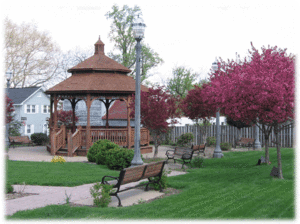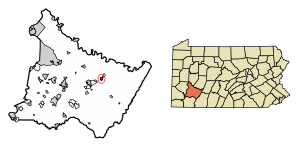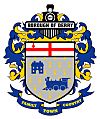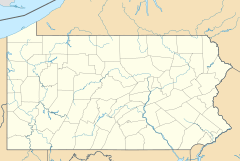Derry, Pennsylvania facts for kids
Quick facts for kids
Derry, Pennsylvania
|
||
|---|---|---|
|
Borough
|
||

Derry's Mossback Park on South Chestnut Street in Derry, Pennsylvania
|
||
|
||
| Motto(s):
"Family, Town & Country"
|
||

Location of Derry in Westmoreland County, Pennsylvania (left) and of Westmoreland Township in Pennsylvania (right)
|
||
| Country | United States | |
| State | Pennsylvania | |
| County | Westmoreland | |
| Settled | 1852 | |
| Incorporated | October 22, 1881 | |
| Government | ||
| • Type | Borough Council | |
| Area | ||
| • Total | 0.80 sq mi (2.06 km2) | |
| • Land | 0.77 sq mi (2.00 km2) | |
| • Water | 0.02 sq mi (0.06 km2) | |
| Elevation | 1,171 ft (357 m) | |
| Population
(2020)
|
||
| • Total | 2,639 | |
| • Density | 3,418.39/sq mi (1,320.00/km2) | |
| Time zone | UTC-5 (Eastern (EST)) | |
| • Summer (DST) | UTC-4 (EDT) | |
| Zip Code |
15627
|
|
| Area code(s) | 724, 878 | |
| FIPS code | 42-18960 | |
| Website | Borough of Derry, Pennsylvania | |
Derry is a small town, called a borough, located in Westmoreland County, Pennsylvania. It is about 45 miles (72 km) east of Pittsburgh. It's important not to confuse Derry Borough with Derry Township, which is a separate area surrounding the borough. In 2020, about 2,637 people lived in Derry.
Contents
Derry's History: From Railroads to Today
Derry has a rich history, especially linked to railroads. It was first settled in 1852 and officially became a borough in 1881.
How Derry Began: The 19th Century
Derry was originally known as Derry Station. It was created to serve the Pennsylvania Railroad, a very important railway company. The town got its name from an older village nearby, now called New Derry. The original "Derry" in Westmoreland County was named after the city of Derry in Ireland. This is because the first non-Native American settlers in the area were Scotch-Irish people.
Derry was a perfect spot for major railroad facilities. It had easy access to water from McGee Run, which was vital for steam locomotives. It also sat on a slight hill along the railroad tracks. In the late 1800s, when railroads were booming, Derry had four hotels, mostly for railroad workers. It also had a roundhouse for fixing locomotives and a huge railroad yard. Derry officially became a borough on October 22, 1881.
Derry in the 20th Century
Derry was a key stop for trains carrying people to and from Pittsburgh until 1964. That's when the Pennsylvania Railroad stopped its commuter service. Today, the annual Railroad Days Festival helps everyone remember Derry's important railroad past.
Not much of the old railroad boom remains. However, you might notice an unused railroad path stretching west from Derry. This was part of a big project called the Derry-Donohoe-Jeannette bypass. The Pennsylvania Railroad tried to build a new main line to avoid curves and hills, bypassing towns like Latrobe and Greensburg. Construction started in the 1920s, but the new route was never finished.
Derry and Latrobe were also connected by an interurban railway, which is like an electric streetcar system. This system, called the Westmoreland County Railway Company, operated from 1904 to 1932.
Understanding Derry's Crest
Derry has an official crest, which is like a special symbol or emblem. It was designed by Borough Councilman Richard L. Allison.
The center of the crest features St. George’s Cross. St. George was a famous figure known for his strong faith and for helping the poor. The heart in the upper left of the cross has a bar rising up, which represents love for God.
The lower part of the shield has a noble ermine pattern. This pattern is a background for two symbols that show the community's values and Derry's railroad history. The railroad theme continues at the top of the design with the borough's name and its establishment date. The decorative leaves around the design are blue, symbolizing loyalty, and gold, symbolizing generosity. These colors also represent the local school's colors and show the borough's dedication to young people and education. The motto at the bottom highlights the strong community for families living in Derry and celebrates the country where Derry is located. The crest truly shows the noble ideas of community, heritage, kindness, and strong faith.
Derry's Geography and Climate
Derry is located at coordinates 40°19′59″N 79°18′4″W / 40.33306°N 79.30111°W. The borough covers about 0.8 square miles (2.06 square kilometers). Most of this area is land, with a small part being water.
Derry's Climate
The weather in Derry has hot, humid summers and winters that are usually mild to cool. According to a system that classifies climates, Derry has a humid subtropical climate. This means it gets plenty of rain throughout the year and has warm temperatures for much of it.
Derry's Population and People
| Historical population | |||
|---|---|---|---|
| Census | Pop. | %± | |
| 1880 | 755 | — | |
| 1890 | 1,968 | 160.7% | |
| 1900 | 2,347 | 19.3% | |
| 1910 | 2,954 | 25.9% | |
| 1920 | 2,889 | −2.2% | |
| 1930 | 3,046 | 5.4% | |
| 1940 | 3,003 | −1.4% | |
| 1950 | 3,752 | 24.9% | |
| 1960 | 3,426 | −8.7% | |
| 1970 | 3,338 | −2.6% | |
| 1980 | 3,072 | −8.0% | |
| 1990 | 2,950 | −4.0% | |
| 2000 | 2,991 | 1.4% | |
| 2010 | 2,688 | −10.1% | |
| 2020 | 2,637 | −1.9% | |
| Sources: | |||
In 2010, there were 2,688 people living in Derry. There were 1,235 households, and 824 families. The population density was about 3,696.5 people per square mile (1,427.2 people per square kilometer).
Most of the people living in Derry are White (99.00%). A small percentage are African American, Native American, or from other races. About 0.47% of the population identified as Hispanic or Latino.
About 29.6% of households had children under 18 living with them. Many households (48.7%) were married couples living together. About 29.6% of all households were made up of individuals living alone. The average household had 2.41 people, and the average family had 2.97 people.
The population's age was spread out. About 24.1% were under 18, and 18.8% were 65 or older. The average age was 40 years.
The average income for a household in Derry was $29,785. For families, the average income was $37,585. About 12.4% of the population lived below the poverty line. This included 16.1% of those under 18 and 7.4% of those 65 or older.
Famous People from Derry
Derry has been home to several notable individuals:
- Herbert Boyer: A chemist who helped start the company Genentech.
- James Patterson: An actor who won a Tony Award.
- William Julius Wilson: An American sociologist and professor at Harvard University.
Images for kids
See also
 In Spanish: Derry (Pensilvania) para niños
In Spanish: Derry (Pensilvania) para niños





